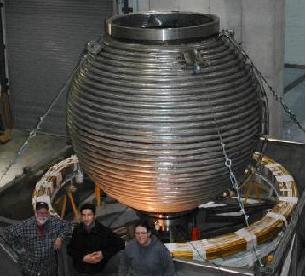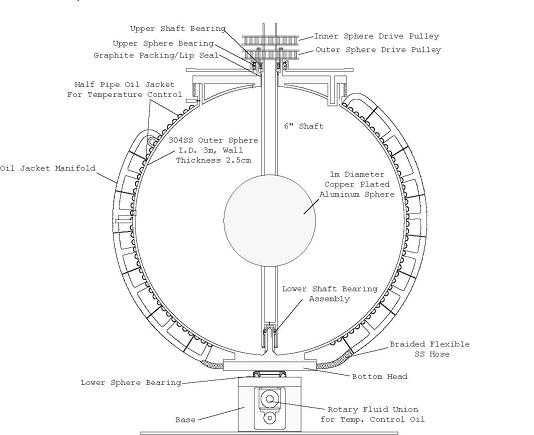
« PREVIOUS ENTRY
Now that’s what I call engineering
NEXT ENTRY »
The environmental cost of Esquire’s e-ink cover

Behold a 30-ton, 10-foot-high spinning ball of steel and sodium that is intended to simulate the Earth’s magnetic field.
Why does this delightful and insane object exist? Because Dan Lathrop, a geophysicist at the University of Maryland, is trying to figure out whether the Earth’s magnetic fields are going to “flip” soon and reverse polarity. The magnetic field is generated by the spinning motions of the Earth’s 12,000-kilometer-thick liquid-iron core. Theoretically, a change in the direction or rate of spin is what flips the north/south polarity, though scientists really don’t understand how this works. We know that the field has flipped hundreds of times in the past; the rock record shows this.
However, since the last flip was 780,000 years ago, we don’t know how a flip would affect life on Earth. It could be pretty nasty: The magnetic field deflects a lot of the Sun’s incredibly nasty radiation, so if you take it away, we could all get microwaved to a crisp. (You may recall that this was the plot to the lafftastically awful sci-fi flick The Core: A military experiment Gone Terribly Awry had shut down the spinning motion of the Earth’s molten core, so a crack team of scientists had to go down and set off some nukes to get it moving again.) Now here’s the scary thing: The Earth’s magnetic field has weakened by 10 per cent since we started measuring it 160 years ago. Does this mean the core is changing speed or direction? Is it going to flip soon?
Nobody knows. So Lathrop decided that the only way to figure it out would be to build scale models of the Earth, by filling spheres with sodium — which is highly interactive with magnetic fields — and spinning them. If he can create a good SimEarth, scientists can begin designing experiments to try and deduce the laws that govern the core, and perhaps make solid predictions about the next flip, giving us time to prepare. As he notes in this interview:
The problem with doing that against the earth directly is that they can make a prediction right now, but you may have to wait 100 years to see if they were right or wrong. The experiment runs relatively more rapidly in terms of the way the magnetic field evolves. So they can make a prediction, which you only have to wait five minutes to test. And so then we can have some give and take in improving the models and building a predictive model for the earth’s field.
Lathrop’s been at this for years, but his first few spheres — only a few feet in diameter — didn’t yield useful results. So now he’s crafted that huger, 10-foot-diameter monster that you see above. To really get a sense of how berserk this thing is, check out this video: As it creaks and groans into action, it looks more like something designed to destroy the Earth than to save it. Personally, I think Lathrop should install a couple of 100,000-volt Tesla coils in the corner of his lab, so they can hurl forty-foot arc lightning over his globe as it spins in its dread revolutions. Wouldn’t do anything, of course, but it’d look awesome.
Oh, and check out the awesome schematics after the jump, below! (They’re taken from one of Lathrop’s presentations.) Viewed in cross-section, his globe looks precisely like a supervillian’s submersible/astronautical lair.

I'm Clive Thompson, the author of Smarter Than You Think: How Technology is Changing Our Minds for the Better (Penguin Press). You can order the book now at Amazon, Barnes and Noble, Powells, Indiebound, or through your local bookstore! I'm also a contributing writer for the New York Times Magazine and a columnist for Wired magazine. Email is here or ping me via the antiquated form of AOL IM (pomeranian99).

ECHO
Erik Weissengruber
Vespaboy
Terri Senft
Tom Igoe
El Rey Del Art
Morgan Noel
Maura Johnston
Cori Eckert
Heather Gold
Andrew Hearst
Chris Allbritton
Bret Dawson
Michele Tepper
Sharyn November
Gail Jaitin
Barnaby Marshall
Frankly, I'd Rather Not
The Shifted Librarian
Ryan Bigge
Nick Denton
Howard Sherman's Nuggets
Serial Deviant
Ellen McDermott
Jeff Liu
Marc Kelsey
Chris Shieh
Iron Monkey
Diversions
Rob Toole
Donut Rock City
Ross Judson
Idle Words
J-Walk Blog
The Antic Muse
Tribblescape
Little Things
Jeff Heer
Abstract Dynamics
Snark Market
Plastic Bag
Sensory Impact
Incoming Signals
MemeFirst
MemoryCard
Majikthise
Ludonauts
Boing Boing
Slashdot
Atrios
Smart Mobs
Plastic
Ludology.org
The Feature
Gizmodo
game girl
Mindjack
Techdirt Wireless News
Corante Gaming blog
Corante Social Software blog
ECHO
SciTech Daily
Arts and Letters Daily
Textually.org
BlogPulse
Robots.net
Alan Reiter's Wireless Data Weblog
Brad DeLong
Viral Marketing Blog
Gameblogs
Slashdot Games